Highlights: Wet start to spring = lawns – powdery mildew & fret over wet mower tires; focus on soilborne diseases on golf putting greens.
Weather
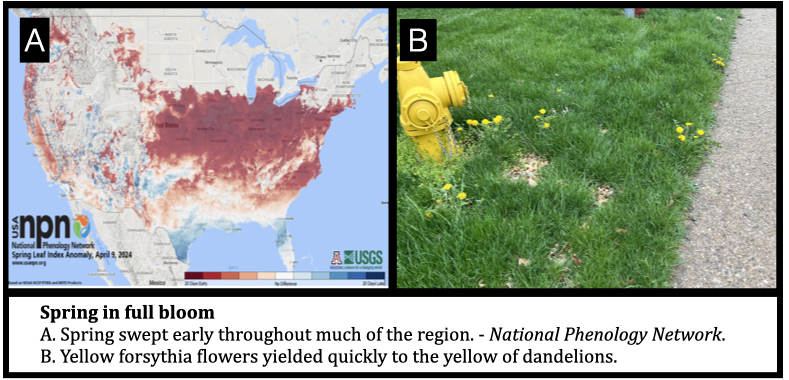
Forgoing May in the popular poem, April showers along with warm temperatures have spurred many spring flowers. Up through middle Indiana, forsythia has fast given way to blooming dandelions, henbit and chickweed, and reports of morel findings have occurred in nearly every county. April temperatures have been fairly on par thus far, with some frost in Indianapolis northward on April 6th. Typical last spring freeze dates in Indiana span the month of April from south (earliest) to north (latest). In southern IN, we are beyond the date of the typical last spring freeze, whereas the middle of the state is mid-April and northern IN is late April (see here for the MRCC Freeze Date Tool). Forecasts indicate temperatures at least to Indianapolis southward will likely not dip well below the freezing mark until next fall.
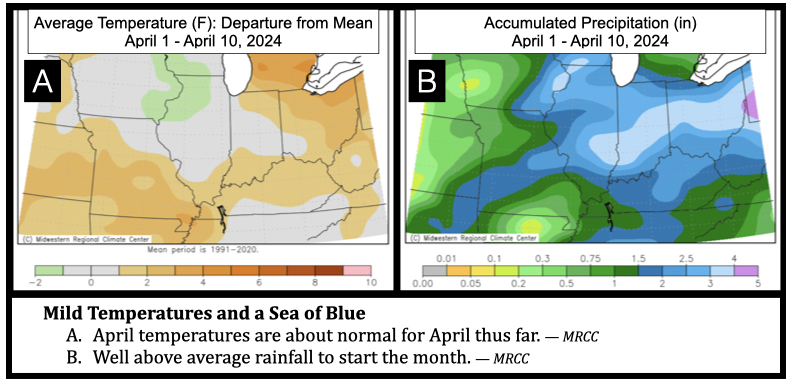
The story this April has been the extreme rainfall events over Indiana, Ohio and Kentucky. Thus far, much of the region has experienced 3-4 inches of rainfall over the first 10 days (see map above), approximating average precipitation amounts for the entire month. Over the past 24 hours, Indianapolis has received 2+ inches of rainfall with the rain still coming down. Soils are saturated, rivers and streams are flooding, and the grass is growing. Much of this report centers on potential disease and plant health issues stemming from this extreme excess.
Warm, above average temperatures are expected through much of next week, with many in Indiana expected to foray past the 80°F mark for the first time in 2024. Rainfall chances are also high next week, further exacerbating the current saturated soil conditions.
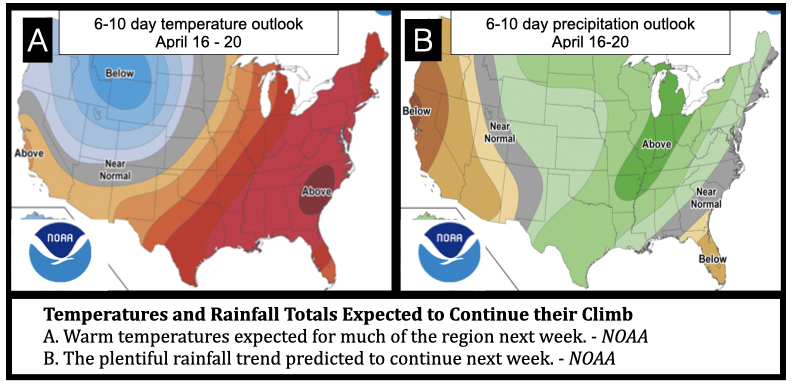
Lawns
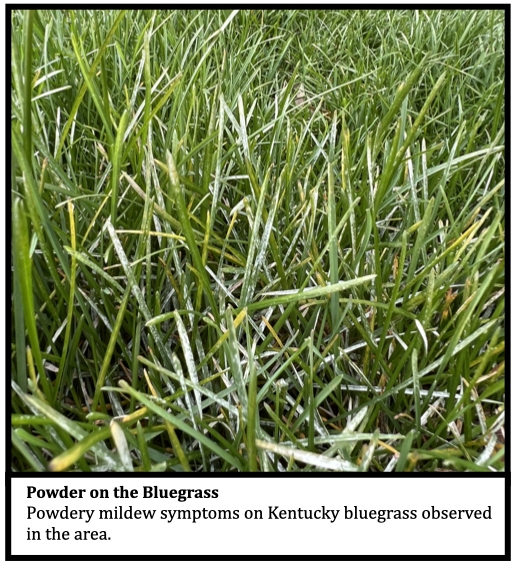
Cool temperatures and ample rainfall over the past week spurred some powdery mildew outbreaks on Kentucky bluegrass in shaded areas around campus. This disease, caused by Blumeria graminis, is easily diagnosed by the white, powdery appearance of the mycelium on leaf blades. Black, round cleistothecia are sometimes observed embedded in the mycelium and house the reproductive ascospores. The disease may cause a general chlorosis, but in most instances is short-lived and doesn’t cause considerable stand decline. Powdery mildew is more severe on heavily fertilized turfgrasses in shaded areas, so if spring nitrogen has already gone down this disease may follow. Controlling the disease centers on reducing shade through selective pruning of trees and ornamentals, restricting excessive spring fertilization, and using shade adapted varieties. The DMI fungicides (i.e. propiconazole, fenarimol, myclobutanil) are effective for control but are rarely necessary.
Watch those Wet Mower Tires!
Now and over the next few weeks, warmer temperatures and plentiful rainfall should have turfgrass leaf growth jumping. Lawns will need to be mowed but the weight from the mower on saturated soils may lead to compaction that will be dealt with all season long. Monitor conditions carefully in this Catch-22 situation. If mowing and the tires are wet consider it a threat, fret, and mow later when conditions allow.
Southern IN: Large Patch on Zoysiagrass
This consistent rain pattern during the period of zoysia emerging from dormancy is a perfect recipe for severe large patch outbreaks this spring. Up at the Daniel Research Center, zoysiagrass is tinging green and we haven’t had observed much large patch in our trials yet, but might expect a big outbreak after this rainfall event. On golf fairways and tees, most will apply one or two fall applications which will afford protection in low pressure conditions through much of spring. In low, poorly drained and/or shaded areas a subsequent spring application is normally recommended with some considering two spring applications. On lawns, normally only one fungicide application is granted. On a lawn with a history of the disease, the best timing for this one shot is now in the spring to afford the longest window of green growth out of dormancy.
Golf Putting Greens – Drainage Check & Act on the Soilbornes
All of this rain leading to saturated soils should make us think about where the water is going. Surface water drainage is a valuable tool but invariably precipitation will end up holding in a putting green soil profile. At this time of year, spring root development should be thought of as bank deposits which soon will be spent in the summer stress period. Roots need oxygen to respire for normal growth and function, and a poorly drained soil doesn’t have much to spare. During site visits, I’ve learned that in many instances the groundwater outlet of a putting green, even USGA sand-based, is of an unknown location or function. On many poorly performing or diseased PITA (fill in the acronym) putting greens, a wet soil profile is the main underlying factor. If not done lately, perhaps use these frequent April rains to break out the as builts and check the outflow of the putting greens for at least a steady trickle.
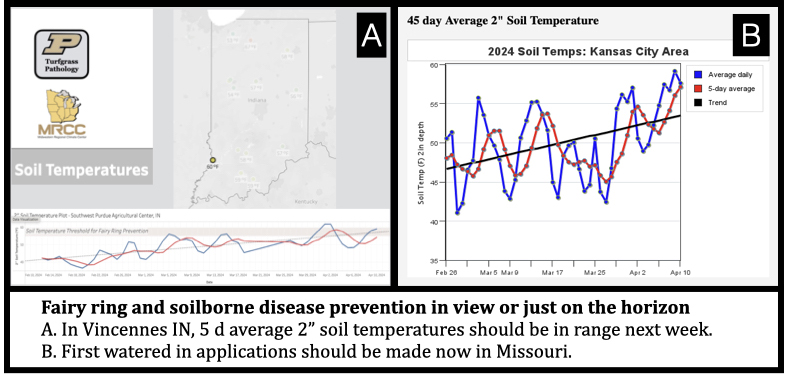
With expected warm temperatures next week, I expect the 55-60°F soil temperature range will be sustained in middle and southern IN, indicating preventive fungicide applications for soilborne diseases on putting greens should be initiated. In Kentucky, Missouri, Cincinnati and much of central and southern IL, the window is open now. For fairy ring and other soilborne diseases such as take-all patch, two preventive DMI applications (i.e. mefentrifluconazole, metconazole, tebuconazole, etc) should be watered in with at least 1/8 inch of post application irrigation. The first application will presumably go down next week for many in Indiana with a second 21-28 days later. The first application will also serve to knock back dollar spot, but a foliar fungicide application in between the two should keep the disease at bay.
In addition, preventive applications targeting Pythium root rot should be planned on greens with a history of the disease over the next few weeks. On newly renovated greens in the last 3-5 years, prevention of Pythium root dysfunction should also be a target. While both of these diseases can be controlled with watered-in applications of picarbutrazox (Serata) or cyazofamid (Segway), remember that they are both termed water molds. If the green profile isn’t draining, these diseases (particularly Pythium root rot) will proliferate and be more severe. If these April rains continue into slightly warmer temperatures they will provide the fuel, and a poorly draining soil profile would spark the fire.
Turfgrass Pathology Program Impact Survey
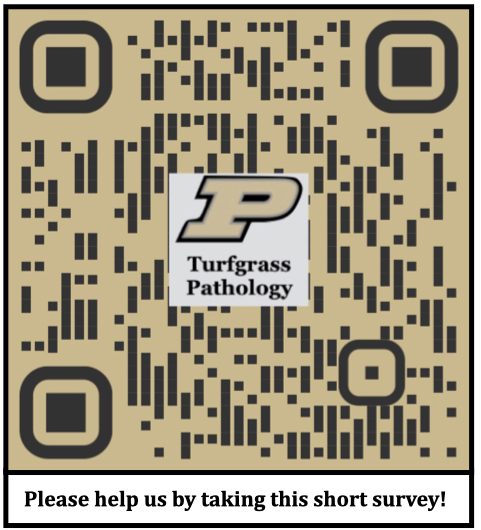
Follow this link or scan QR code above to access the survey.
SAVE THE DATE: Purdue Turfgrass and Landscape Field Day – Tuesday, July 16th
Lee Miller
Extension Turfgrass Pathologist – Purdue University
Follow on Twitter: @purdueturfpath